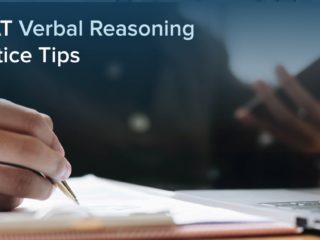| Getting your Trinity Audio player ready... |
In many ways, algebra is the driver of the quantitative section of the GMAT. You’ll encounter straightforward GMAT algebra questions, obviously, but you’ll also find that algebra is a tool for solving any number of other quantitative questions. These include topics as diverse as word problems, quadratic equations, combinations, functions, and statistics.
So, in this article, we will first cover some general rules involving algebra and linear equations. Then, we’ll present several GMAT algebra practice questions that are not pure algebra but require algebraic manipulation to get to the correct answer.
Here are the topics we’ll cover:
- Basic Algebra – Single-Variable Linear Equations
- Linear Equations with Two Variables
- Algebra Can Show Up Almost Anywhere in GMAT Quant
- Algebra Example 1: General Word Problems – Two Variables
- Algebra Example 2: Exponents – One Variable
- Algebra Example 3: Work Problems – One Variable
- Algebra Example 4: Ratios – One Variable
- Algebra Example 5: Statistics – Two Variables
- Algebra Example 6: Geometry – Two Variables
- Algebra Example 7: Probability – Two Variables
- Algebra Example 8: Percents – One Variable
- In Conclusion: GMAT Algebra Questions
- What’s Next?
Before considering how algebra is used as a tool for solving various questions, let’s cover some basic skills – how to solve simple equations or algebraic expressions with one variable and how to solve simultaneous equations. We’ll start with how to solve an equation when we have just one variable and then move to some more difficult questions testing advanced algebra techniques for GMAT preparation.
Basic Algebra – Single-Variable Linear Equations
The most basic algebra questions on the GMAT are single-variable linear equations. Your goal is to solve for the value of the variable:
- 2x + 5 = x
- 4 = 5n
- 2v + 5 = 3v – 7
Note that solving single-variable equations generally requires that we combine all terms containing the variable on one side of the equation and all constant terms on the other side.
Let’s practice simplifying and solving an equation with one variable.
If 5m – 1 = 10m – 16, what is the value of m?
First, we combine our constant terms by adding 16 to both sides.
5m – 1 + 16 = 10m – 16 + 16
5m + 15 = 10m
Next, we combine the variable terms by subtracting 5m from both sides of the equation.
5m + 15 – 5m = 10m -5m
15 = 5m
Finally, we divide both sides of the equation by 5 to isolate the variable. So, we have:
15 / 5 = 5m / 5
3 = m
KEY FACT:
When solving for a single variable, we combine like terms and isolate the variable we are solving for.
Now, let’s practice with an example.
Example 1: Linear Equation with One Variable
If 7x + 14 = 5x + 32, then x equals which of the following?
- 9
- 7
- 6
- 4
- 3
Solution:
7x + 14 = 5x + 32
7x = 5x + 18
2x = 18
x = 9
Answer: A
Next, let’s discuss linear equations with two variables.
Linear Equations with Two Variables
As you may expect, two-variable equations have not just one but two different variables:
- v – u = 12
- 2x + y = 10
- 5z – 3y = 42
These are two-variable equations because they contain two different variables. So, to solve these problems, we need a second equation that has one or both of those variables. The two equations are called a system of linear equations. One common way to solve for the values of the variables is by using the substitution method. Let’s discuss the substitution method now.
Using the Substitution Method to Solve a System of Linear Equations
When we’re dealing with two equations, the essence of the substitution method is that we isolate one variable in one of the equations and then substitute whatever that variable is equal to into the other equation. Let’s practice with an example.
Substitution Method Practice 1
In the system of linear equations below, determine the value of n.
m = 3n (equation 1)
m + n = 12 (equation 2)
Solution:
Looking at our two equations, we see that m is already isolated in equation 1. So, we can substitute 3n (from equation 1) for m (in equation 2). This gives us:
3n + n = 12
4n = 12
n = 3
Substitution Method Practice 2
In the system of linear equations below, what is the value of x?
5x + y = 14 (equation 1)
3x + 4y = 22 (equation 2)
Solution:
We will have to do a bit of work to isolate a variable. Let’s isolate y in equation 1 by subtracting 5x from both sides of the equation:
5x + y = 14 (equation 1)
y = 14 – 5x
Now, we can substitute 14 – 5x for y into equation 2. This gives us:
3x + 4(14 – 5x) = 22
3x + 56 – 20x = 22
-17x = -34
x = 2
KEY FACT:
We can use the substitution method to solve a system of linear equations.
Next, let’s discuss the many topics on the GMAT in which we use algebra to determine the solution.
Algebra Can Show Up Almost Anywhere in GMAT Quant
Thus far, we have covered how to deal with pure algebra questions for solving one- and two-variable equations. Understanding the processes we’ve covered is very important because you might need to use them when you’re confronted with questions from essentially any GMAT Quant topic. In this article, we will use algebra as the problem-solving tool for questions from the following disciplines:
- Word Problems
- Exponents
- Work
- Ratios
- Statistics
- Geometry
- Probability
- Percents
Of course, algebra is also used as a tool in GMAT Quant questions testing such varied disciplines as overlapping sets, combinations and permutations, coordinate geometry, functions, number properties, polynomials, inequalities, absolute value, and sequences.
As you can see, many Quant topics require the use of algebra! Don’t be overly concerned! First, use your knowledge of the specific topic to craft your approach and then integrate algebra into the solution process. Your solid knowledge of algebra will serve you well in solving a variety of problems. Also, keep in mind that algebra deals with both integers and fractions, so you don’t need to know any specific integer properties to deal with algebra.
TTP PRO TIP:
Be prepared to use your algebra skills to solve a variety of GMAT Quant questions.
Algebra Example 1: General Word Problems – Two Variables
Jane sold 20 more boxes of cookies than Sally. If Jane and Sally sold a combined total of 38 boxes of cookies, how many boxes did Sally sell?
- 4
- 6
- 8
- 9
- 12
Solution:
Let’s first define our two variables:
We can let J = the number of boxes of cookies Jane sold and S = the number of boxes of cookies that Sally sold.
Next, we can create two equations. Since Jane sold 20 more boxes than Sally, we have:
J = S + 20 (equation 1)
Since Jane and Sally sold a combined total of 38 boxes, we have:
J + S = 38 (equation 2)
The variable J is already isolated in equation 1, so we can substitute S + 20 for J in equation 2:
S + 20 + S = 38
2S + 20 = 38
2S = 18
S = 9
Sally sold 9 boxes of cookies.
Answer: D
Next, let’s see how algebra can be presented in an exponent question.
Algebra Example 2: Exponents – One Variable
If (4^4x)(64^4) = (256^3x), then x is equal to which of the following?
- 0.25
- 1.5
- 2
- 3.5
- 4
Solution:
It is important to first note that each of the bases — 4, 64, and 256 — is a power of 4. We can express each exponential term using 4 as its base.
64^4 = (4^3)^4 = 4^12
256^3x = (4^4)^3x = 4^12x
The original equation can now be re-expressed as:
(4^4x)(4^12) = 4^12x
4^(4x + 12) = 4^12x
Because the bases are the same, we can equate the exponents and solve for the value of x:
4x + 12 = 12x
12 = 8x
12/8 = x
3/2 = 1.5 = x
Answer: B
Let’s see how algebra is used to solve work problems.
Algebra Example 3: Work Problems – One Variable
Two pipes are filling a pool. Pipe A can fill the pool in 4 hours, and Pipe B can fill the pool in 5 hours. If both pipes are filling the pool at their respective rates at the same time, how long will it take to fill the pool?
- 17/9
- 20/9
- 3
- 24/9
- 4.5
Solution:
Since Pipe A can fill the pool in 4 hours, its rate is 1/4 pool per hour.
Since Pipe B can complete the same job in 5 hours, its rate is 1/5 pool per hour.
Since they are working together to complete the job, we can let the time they work together = t.
Thus, the work done by Pipe A is t/4, and the work done by Pipe B is t/5.
Next, we can use the combined work formula to determine t:
Work of Pipe A + Work of Pipe B = 1
t/4 + t/5 = 1
Multiplying both sides of the equation by 20, we are left with:
5t + 4t = 20
9t = 20
t = 20/9 hours
Answer: B
Let’s now consider a question involving ratios.
Algebra Example 4: Ratios – One Variable
A pasture contains only horses, ponies, and goats. If the ratio of horses to ponies to goats is 2 to 5 to 8, and if there are 45 animals in the pasture, how many goats are in the pasture?
- 6
- 15
- 20
- 24
- 30
Solution:
First, we can express the ratio using the ratio multiplier.
horses : ponies : goats = 2x : 5x : 8x
Since there are 45 animals in the pasture, we have:
2x + 5x + 8x = 45
15x = 45
x = 3
Since there are 8x goats, the total number of goats in the pasture is 8(3) = 24.
Answer: D
Algebra Example 5: Statistics – Two Variables
From a particular distribution, a data point of 122.5 is 1.5 standard deviations above the mean, and a second data point of 62.5 is 2.5 standard deviations below the mean. What is the mean of the data set?
- 50
- 70
- 85
- 100
- 115
Solution:
Let’s let m = the mean and s = the standard deviation. We can now create two equations.:
Since 122.5 is 1.5 standard deviations above the mean, we have:
122.5 = m + 1.5s
m = 122.5 – 1.5s (equation 1)
Since the second data point of 62.5 is 2.5 standard deviations below the mean, we have:
62.5 = m – 2.5s (equation 2)
We can use the substitution method, substituting 122.5 – 1.5s from equation 1 for m in equation 2, giving us:
62.5 = 122.5 – 1.5s – 2.5s
4s = 60
s = 15
We can use either equation 1 or 2 to solve for m, the value of the mean:
m = 122.5 – 1.5(15)
m = 122.5 – 22.5
m = 100
Answer: D
Algebra Example 6: Geometry – Two Variables
If lines a and b are parallel, what is the value of x – y?
- 30
- 45
- 50
- 60
- 65
Solution:
We have two parallel lines and a transversal. We use the fact that the angles with measures x + 60 and 2x are corresponding angles, so they have equal measures. We can create the following equation:
x + 60 = 2x
60 = x
Now we use the fact that the angles with measure 2x and 2y are supplementary angles, so their sum is 180 degrees:
2x + 2y = 180
x + y = 90
Since x = 60, we now have:
60 + y = 90
y = 30
Thus, we see that x – y = 60 – 30 = 30.
Answer: A
Algebra Example 7: Probability – Two Variables
A jar contains only green and yellow marbles. The probability of selecting a green marble is 1/5. If there are 12 more yellow marbles than green marbles, how many green marbles are in the jar?
- 4
- 8
- 12
- 16
- 18
Solution:
Let’s let the number of green marbles = g and the number of yellow marbles = y. Thus, the total number of marbles is g + y.
Since the probability of selecting a green marble is 1/5, we have:
g / (g + y) = 1/5
5g = g + y
4g = y (equation 1)
Next, since there are 12 more yellow marbles than green marbles, we have:
y = g + 12 (equation 2)
From equation 1, we know that 4g = y. So, we substitute 4g for y in equation 2. This gives us:
4g = g + 12
3g = 12
g = 4
Answer: D
Algebra Example 8: Percents – One Variable
Arjun was trying to sell his lawnmower. No one bought it, so he marked the price down 50 percent. Because it still had not sold, he decreased the price by an additional 25 percent of the discounted price before selling it for $600. What was the original asking price of his lawnmower?
- $1,200
- $1,600
- $1,700
- $2,500
- $3,200
Solution:
We can let the original asking price of the lawnmower = p.
After being marked down 50%, the new price is 0.50p.
After being marked down an additional 25% from the discounted price, the new price is 0.75 * 0.50p = 0.375p.
Since the final price is $600, we can create the following equation and use it to determine p:
0.375p = 600
375p = 600,000
p = 1,600
Answer: B
In Conclusion: GMAT Algebra Questions
Having solid algebra skills is necessary for earning a great GMAT score! Algebra is tested in a variety of question types, so getting practice with a variety of Quant topics that use algebra is an investment that gives you a great rate of return.
Two fundamental algebra concepts that you must know intimately are:
- solving a linear equation with one variable
- using the substitution method to solve a system of two linear equations
Mastery of these two equation-solving techniques will help you solve a variety of GMAT math questions, including general word problems, exponents, work, ratios, statistics, geometry, probability, and percents.
What’s Next?
Realizing that algebra is used in essentially all Quant topics is a huge step in doing well on GMAT Quant. If you feel more confident with your algebra skills but still feel that you need some help with Quant, I welcome you to read this article about improving your GMAT Quant score. And if you want some additional algebra practice, check out the 5-day trial of our GMAT self-study course.



